
Ficus is a genus of about 850 species of woody trees, shrubs, vines, epiphytes and hemiepiphytes in the family Moraceae. Collectively known as fig trees or figs, they are native throughout the tropics with a few species extending into the semi-warm temperate zone. The common fig (F. carica) is a temperate species native to southwest Asia and the Mediterranean region, which has been widely cultivated from ancient times for its fruit, also referred to as figs. The fruit of most other species are also edible though they are usually of only local economic importance or eaten as bushfood. However, they are extremely important food resources for wildlife. Figs are also of considerable cultural importance throughout the tropics, both as objects of worship and for their many practical uses.

Ficus benjamina, commonly known as weeping fig, benjamin fig or ficus tree, and often sold in stores as just ficus, is a species of flowering plant in the family Moraceae, native to Asia and Australia. It is the official tree of Bangkok. The species is also naturalized in the West Indies and in the states of Florida and Arizona in the United States. It is one of the most common trees in Israeli cities and parks. In its native range, its small fruit are favored by some birds.

Ficus microcarpa, also known as Chinese banyan, Malayan banyan, Indian laurel, curtain fig, or gajumaru (ガジュマル), is a tree in the fig family Moraceae. It is native in a range from China through tropical Asia and the Caroline Islands to Australia. It is widely planted as a shade tree and frequently misidentified as F. retusa or as F. nitida.
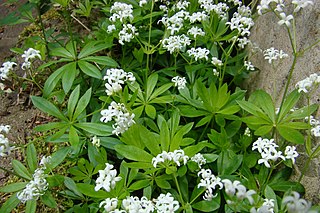
Galium odoratum, the sweet woodruff or sweetscented bedstraw, is a flowering perennial plant in the family Rubiaceae, native to much of Europe from Spain and Ireland to Russia, as well as Western Siberia, Turkey, Iran, the Caucasus, China and Japan. It is also sparingly naturalised in scattered locations in the United States and Canada. It is widely cultivated for its flowers and its sweet-smelling foliage.

Ficus tinctoria, also known as dye fig, or humped fig is a hemiepiphytic tree of genus Ficus. It is also one of the species known as strangler fig.

Pseudocydonia sinensis or Chinese quince is a deciduous or semi-evergreen tree in the family Rosaceae, native to southern and eastern China. It is the sole species in the genus Pseudocydonia. Its hard, astringent fruit is used in traditional Chinese medicine and as a food in East Asia. Trees are generally 10–18 metres (33–59 ft) tall.
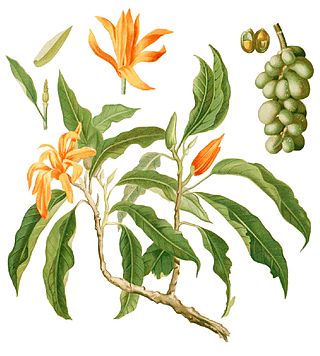
Magnolia champaca, known in English as champak, is a large evergreen tree in the family Magnoliaceae. It was previously classified as Michelia champaca. It is known for its fragrant flowers, and its timber used in woodworking.

Ulmus lanceifoliaRoxburgh, ex Wall., occasionally known as the Vietnam elm, is a very large tree endemic to a wide area of southern Asia. Its range extends southeast and eastwards from Darjeeling in the Himalaya, through Bangladesh, southern China, Myanmar, Thailand, Laos, Vietnam and on discontinuously into Indonesia, straddling the Equator in Sumatra and Celebes.
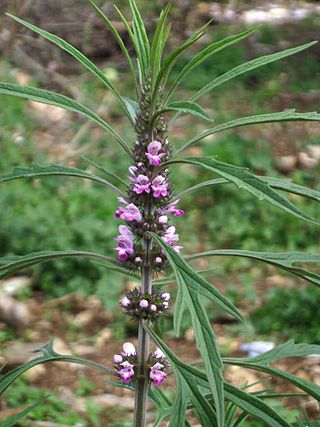
Leonurus sibiricus, commonly called honeyweed or Siberian motherwort, is an herbaceous plant species native to China, Mongolia, and Siberia. It has verticillaster inflorescence. It is naturalized in many other parts of the world, including South, Central and North Americas.

Butomus is the only known genus in the plant family Butomaceae, native to Europe and Asia. It is considered invasive in some parts of the United States.

Crataegus cuneata is a species of hawthorn known by the common names Chinese hawthorn or Japanese hawthorn. It is native to China, and is widely cultivated in Japan. It is used for bonsai. The fruit can be red or yellow. Its habitats include valleys and thickets.

Geranium himalayense is a species of hardy flowering herbaceous perennial plant in the genus Geranium, family Geraniaceae. It is native to West Himalaya, Afghanistan, Kyrgyzstan, Nepal, Pakistan, Tajikistan, Tibet, and Uzbekistan.

The fig is the edible fruit of Ficus carica, a species of small tree in the flowering plant family Moraceae, native to the Mediterranean region, together with western and southern Asia. It has been cultivated since ancient times and is now widely grown throughout the world. Ficus carica is the type species of the genus Ficus, containing over 800 tropical and subtropical plant species.

Mussaenda macrophylla, commonly known as sweet root is an evergreen Asian shrub. The bracts of the shrub may have different shades, including red, white or some mixtures. M. macrophylla is native to Asian countries like China, Taiwan, Nepal, Myanmar, Malaysia, Philippines.
Iris curvifolia is a plant species in the genus Iris, it is also in the subgenus of Iris, and in the Psammiris section. It is a rhizomatous perennial, from China. It has sickle-shaped long leaves, short stem and yellow or bright yellow flowers. It is cultivated as an ornamental plant in temperate regions.
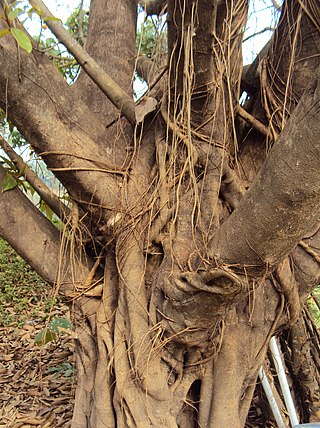
Ficus drupacea, also known as the brown-woolly fig or Mysore fig, is a tropical tree native to Southeast Asia and Northeast Australia. It is a strangler fig; it begins its life cycle as an epiphyte on a larger tree, which it eventually engulfs. Its distinctive features include dense, woolly pubescence, bright yellow to red fleshy fruit, and grayish white bark. It can reach heights of 10–30 meters (33–98 ft). Its fruit are eaten by pigeons, and it is pollinated by Eupristina belgaumensis. It occurs in environments ranging from sea-level beachfront environments to montane forests, up to 1000 m (3281 ft).
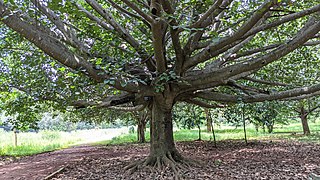
Ficus drupacea var. pubescens, also known as the Mysore fig or brown woolly fig, is a variety of F. drupacea distinguished by its fruits and leaves having a dense yellow-brown pubescence. It is naturally distributed throughout Southeast Asia, and has been introduced elsewhere. It forms a distinct shape with large, buttressing roots. Its leaves are characterized by a distinctly pointed tip, and it is pollinated by small wasps.

Saccharum sinense or Saccharum × sinense, synonym Saccharum × barberi, sugarcane, is strong-growing species of grass (Poaceae) in the genus Saccharum. It is originally cultivated in Guangzhou, China where it is still commonly grown. It is a more primitive form of sugarcane with a hybrid origin from Saccharum officinarum and Saccharum spontaneum species of cane. A number of clones exists that are often included in the S. officinarum species as the Pansahi group. The most notable member of which is the Uba variety of cane. They are a perennial plant that grows in erect clumps that can reach up to 5 meters in height and have a red cane with a diameter of 15 mm to 30 mm.

Ficus erecta, the Japanese fig, is a species of flowering plant in the family Moraceae. It is found in the eastern Himalayas, Assam, Bangladesh, Vietnam, southern China, Taiwan, Jeju Island of South Korea, the Ryukyu Islands, and Japan. A deciduous shrub or small tree from 2 to 7 m in height, it is found alongside streams. Said to be dioecious, it has small fruit that are 1.0 to 2.5 cm in diameter, and quite sweet.

Ficus ampelos is a species of fig in the family Moraceae, native to Bangladesh, the Nicobar Islands, Malesia, Papuasia, Taiwan, and the Ryukyu Islands. A small evergreen tree, it is usually found in broad-leafed evergreen forests at around 600 m (2,000 ft) in elevation.




















